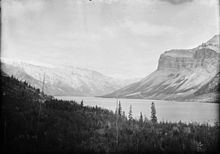Type Geological formation Region Alberta Province Alberta Overlies Alexo Formation Primary Limestone, Dolostone | Other Anhydrite Country Canada Named for Palliser Range Underlies Exshaw Formation | |
 | ||
Sub-units Moro Member, Costigan Member Thickness up to 580 metres (1,900 ft) | ||
The Palliser Formation is a stratigraphic unit of Late Devonian (Famennian) age in the Western Canada Sedimentary Basin. It is a thick sequence of limestone and dolomitic limestone that is present in the Canadian Rockies and foothills of western Alberta. Tall cliffs formed of the Palliser Formation can be seen throughout Banff and Jasper National Parks.
Contents
- Lithology and paleontologyEdit
- Distribution and thicknessEdit
- Relationship to other unitsEdit
- References
The formation was named for the Palliser Range in Banff National Park (which in turn took its name from John Palliser, the leader of the 1850s Palliser Expedition), by H.H. Beach in 1943. The type locality was defined in 1994 by Meijer Drees and Johnston in the "Devil's Gap" section south of Mount Costigan of the Palliser Range, north of Lake Minnewanka.
Lithology and paleontologyEdit
The Palliser Formation was deposited in a marine environment as an extensive carbonate shelf. It is subdivided into the Morro Member (the lower part) and the Costigan Member (the upper part). The Morro Member consists of massive, fine-grained limestone and dolomitic limestone. It contains remains of brachiopods, crinoids, gastropods, ostracods and conodont elements. The Costigan is less dolomitic, more argillaceous, and more fossiliferous than the Morro. It contains remains of brachiopods, crinoids, conodont elements, nautiloids, bryozoans, stromatoporiods and stromatolites. Anhydrite beds can occur in both members.
Distribution and thicknessEdit
The Palliser Formation is present throughout the main and front ranges of the Canadian Rockies, where it reaches a maximum thickness of 580 metres (1,900 ft), as well as in the subsurface in the foothills, where it is up to 240 metres (790 ft) thick.
Relationship to other unitsEdit
The Palliser Formation is disconformably overlain by the Exshaw Formation and conformably underlain by the Alexo Formation. It is equivalent to the Wabamun Group in central Alberta, to the middle part of the Three Forks Formation in Saskatchewan and Montana and to the Tetcho Formation and Kotcho Formation in the Fort Nelson area of British Columbia.
